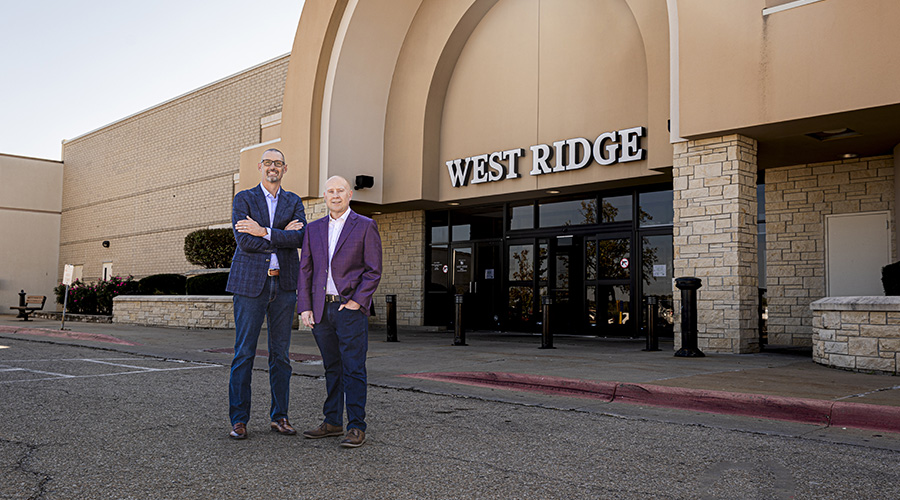-(1).jpg) The Curtis in Philadelphia is an example of what building owners can achieve when moving properties to mixed use. Keystone Development + Investment
The Curtis in Philadelphia is an example of what building owners can achieve when moving properties to mixed use. Keystone Development + InvestmentHow to Reimagine Office Spaces Post-Pandemic
Building owners are considering sweeping changes in hopes of bringing back tenants.
Complete shutdowns of all but essential services during the COVID-19 pandemic forever changed the way companies view and use office buildings. Two years later, firms still have employees working from home or hybrid work models.
In fact, a recent Steelcase study found 23 percent of organizations expect employees to work at the office, 72 percent take a hybrid approach and just 5 percent still allow workers to work remotely.
“Everybody’s doing what feels right for their company and their operations,” says Heather DeFreytas, construction manager for Keystone Development + Investment.
COVID-19 also amplified health and wellness trends for commercial buildings. Today’s workspaces must reinforce company culture, foster collaboration, and drive innovation as they safeguard public health. With staying healthy a top employee concern, companies now invest in upgrades meant to improve health while reimagining workspaces and how they function.
These shifts alter the future of office buildings, leaving the fate of many urban and suburban facilities uncertain. Nationally, vacancies now average 20 percent for office buildings.
Overall, companies have consolidated their office spaces by 10-20 percent. However, some firms use the extra space to spread out desking, create larger corridors, and multipurpose areas. Joanne Fields, an interior designer at Oculus Inc., predicts companies will move operations into buildings with better ventilation systems and more amenities once their leases expire.
“Unfortunately,” she says, “this means some buildings will struggle to find tenants to lease their spaces.”
But Robert Kramp, vice president of research for Transwestern Real Estate, insists office buildings are not going away, they are just taking on a different form.
“If we have another situation in the future, (businesses) will want the ability to shut off certain office spaces or have built-in social distancing,” he said in an article titled, “Office Space: Companies Seek New Physical Footprint.”
What’s being done
The solutions building owners embrace vary as much as the work scenarios, says Stacey Olson, director of sustainability at Gensler.
Overall, new uses are at the tip of the iceberg, Fields says.
“When leases start to expire, it will be very tough, and the market will not be the same,” she says. “It’s likely building owners will consider converting empty office space into apartments and condos, but it’s too early to say, or see this happening, since leases have not expired.”
But Olson stresses the shift has already begun. Gensler recently repositioned a Los Angeles building into an art gallery and creative hub. The company also made a single tenant property in San Antonio multi-tenant while adding a public theater, digital design experiences (DXD), and direct connection to the riverfront. Gensler also repositioned a 24-story office building in Philadelphia into a mixed-use facility with residential living.
The sky’s the limit when considering how empty or half-empty office real estate gets used in the post-pandemic world.
Mixed-use buildings
A mixed-use building combines different occupancy groups in a single building. These buildings can include work centers and office spaces, residential apartments and condos, health and wellness facilities, retail shops, restaurants, daycare centers and other amenities.
Since the pandemic, there’s been a trend toward mixed-use buildings, which helps building owners secure income rentals from a variety of sources while ensuring buildings remain fully occupied.
Similar examples across the country include:
- Granite Properties upgraded seven office buildings in Los Angeles and Orange County with advanced HVAC air filtration systems, UV lighting, automatic doors, touchless fixtures, foot-operated door openers and more.
- Tenants at EQ Office’s Canvas office building now use mobile phones to open office doors and enter other parts of the building.
- Architecture firm Rios upgraded its Los Angeles building to create more open collaborative spaces, improve ventilation, and install floor-to-ceiling sliding glass doors between workspaces.
- Keystone’s 1K1 project uses smart glass technology that adjusts light coming into the building as it changes throughout the day. This multimillion-dollar redevelopment program also includes a four-story, “jewel box” main entrance; renewed common areas and restrooms; and an upgraded, six-level garage.
“The benefit of a mixed-use building is we maximize building use and ensure they are fully occupied,” DeFreytas says. “Tenants who want to live and work in the same building are attracted to mixed-use properties.”
Hannah Rohlfing, an interior designer at Oculus Inc., expects this trend to continue.
“We’re expecting to see many commercial office buildings renovate their office suites into residential apartments,” Rolfing says.
The Curtis in Philadelphia provides a notable example of what building owners can achieve when moving properties to mixed use. Keystone purchased the building for $125 million, then restored its massive 12-story atrium and added 86 luxury residential units. Residents enter the main lobby then take private elevators to their apartments and amenities on upper floors. The building also houses life science tenants, offices, retail shops, restaurants and other amenities.
“The building is a little bit of everything,” DeFreytas says. “And it has been very successful.”
Reimagined office spaces
Pre-pandemic, two-thirds of U.S. office workers worked in open office environments, but only half of employers consider this ideal going forward, finds Gensler’s 2021 Workplace Survey. Gensler’s research also revealed three-fourths of employees ranked access to private spaces in the office as a priority upon returning to work, a factor outranked only by enhanced filtration and cleaning protocols.
“While this is consistent with our pre-pandemic research, the desire for privacy in the office has become a growing expectation during the period of remote work,” the study states.
The move toward hybrid work models helps companies accommodate these concerns. Fields says as companies move to a hybrid model, they only need 60 percent of desk space in their physical offices.
“This can result in significant cost savings on long-term operating costs and real estate (as it allows them to consolidate the overall office footprint). The hybrid model also gives employees a better experience,” she says.
Rohlfing stresses building owners now seek more spaces equipped to hold virtual meetings of assorted sizes and scale with acoustic privacy and upgraded technology to support video conference calls.
“They also modified low height workstations to create greater division and social distancing between workers,” she says.
As more people return to the office, Fields recommends larger companies invest in technology that tracks office usage via hot desks and booking technology. This allows companies to monitor actual office use and employee collaboration styles and preferences.
“Building owners can make educated design decisions that are customized to their office and employees instead of following a trend,” she says.
Keep health a priority
As uses change, protecting occupant health becomes a key concern. Occupants need clean air and clean facilities, and their needs evolve as building uses shift. Facilities must consider ventilation system upgrades and design that incorporates standards such as WELL and Fitwel, Fields says.
Poor indoor air quality can make people ill. Short-term exposures irritate people’s eyes, nose and throat, leading to headaches, dizziness, fatigue and worse asthma symptoms. Long-term exposure can lead to respiratory diseases, heart disease and even cancer. COVID-19 adds another layer of concern. But research suggests it is possible to lower coronavirus transmission by increasing fresh air ventilation and keeping air more humid.
As companies ask for more outside, fresh air, building owners must consider HVAC systems and filter use. Simply using MERV-13 filters and replacing them every 90 days can improve air quality, according to the American Society of Heating, Refrigerating and Air Conditioning Engineers (ASHRAE).
Modern technologies also can boost building health. Adding a needlepoint bipolar ionization air filtration system to HVAC systems filters out key contaminants, including COVID-19, tuberculosis, flu strains and the common cold. These devices install easily and provide an effective tool to purify the air.
Cleaning considerations also must evolve in shifts to mixed used. A multi-use building has differing cleaning needs. For instance, the times to clean a residential lobby versus an office lobby may differ. Apartment tenants may not want cleaning staff running a vacuum in the evening while office workers may not appreciate mid-day cleaning.
“Buildings also need extra cleaning for health reasons,” DeFreytas says. “It’s definitely more challenging for building managers. We almost need them around the clock. These buildings operate 24 hours a day. There is little downtime for repairs or upgrades. It’s definitely trickier to manage.”
Key concerns as uses shift
All agree, electrical and other mechanical concerns crop up as building uses shift.
“Electrical can be a problem when moving to mixed use,” DeFreytas says. “You must consider what’s required and ensure you have enough room for new equipment and mechanicals. You may need to build additional mechanical rooms if you lack space on the roof or outside. This takes away square footage in the building.”
She recommends building engineers consider the following:
- Can we use existing systems, or must we add new systems?
- Can the building handle additional plumbing?
- Does enough water come into the building to handle additional plumbing?
- Do you need to add generators to support operations that cannot afford downtime?
- Where will additional ductwork and pipes go?
- Can the structure handle mixed use? Structurally, some office buildings may not hold up to heavier use. A structural engineer must analyze the building to make this call.
“We must do all this research in the beginning to support these projects,” DeFreytas says. “We go through a due diligence process, then take it to the next level. Sometimes along the way, we decide the project makes little sense. You must make sure mechanical systems can support various uses.”
Ronnie Wendt is a freelance writer based in Waukesha, Wisconsin.
Related Topics:








-(1).jpg)




